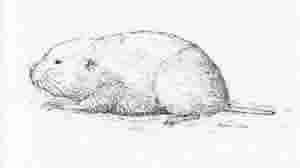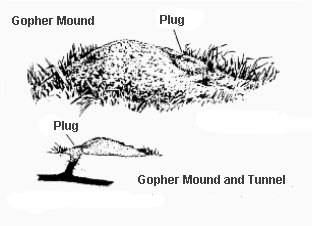|
Description
Pocket gophers are thick bodied rodents five to seven inches long with
a short sparsely haired tail, wide head, very small eyes and ears,
strongly clawed front feet which are well suited for digging. They have
external, fur-lined cheek pouches or "pockets" (hence the name pocket
gopher) that they use to transport food. They do not transport soil in
these pouches. Their large incisors are used for cutting roots and
other plant parts as well as for digging. Their cheeks close behind the
incisors which are always exposed. Pocket gophers have pale to dark
brown soft fur.
Distribution in Arizona

Pocket Gopher
|
There are three species of pocket gophers in Arizona. All three species
belong to the genus Thomomys. The most common species is Thomomys
bottae commonly known as the Botta's or valley pocket gopher. Pocket
gophers are found throughout Arizona in any most any habitat in which
sufficient amounts of tuberous roots and other plant material are
available and the soil is suitable for digging tunnels.
Legal Status in Arizona
Pocket gophers are classified as non-game animals by the Arizona Game
and Fish Department and are protected under ARS Title 17-309. However,
they may be controlled by any legal means if they are causing damage as
provided under ARS Title 17-239.
Life History and Behavior
Pocket gophers live most of their
lives in underground burrow systems or runways they have dug. They will
occasionally venture above ground to feed on plants close to the burrow
entrance or to seek new territory. Except during the breeding season,
pocket gophers are solitary and will defend their burrow system against
any intruders, including other pocket gophers.
Pocket gopher burrow systems consist of a main
tunnel or runway which is commonly six to eight inches below the
surface, but this depth can vary greatly with the type of soil. Runways
are about three inches in diameter, but will vary with the size of the
particular gopher. Some runways leading to nests or food caches may be
three or more feet deep. Soil is excavated from short lateral runways
leading off from the main runway. The soil is pushed to the surface,
most often forming a distinctive horseshoe or fan-shaped mound. Each
time the gopher finishes pushing soil from a lateral the entrance hole
is plugged with soil. These plugs help exclude others animals and serve
to maintain moisture and temperature within the normally closed burrow
system.
Pocket gophers are very sensitive to breaches of light or air into
their burrow system. They will attempt to plug any sources of light or
air entering the burrow system. Pocket gophers will also commonly plug
a main runway with soil to block off predators such as snakes. The
runway system constitutes the home range of a pocket gopher which may
be up to 700 square yards.
In Arizona, pocket gophers may produce young
throughout the year. At higher altitudes young are produced mainly in
June and July and one litter is produced per year. At lower elevations,
there may be two litters produced per year with young born mainly from
December through May and from mid-July through August.
Litter size may vary from one to ten but averages five to six. The
gestation period is about 30 days and the young remain in the nest for
several weeks. After weaning the young are expelled by the mother and
often wander above the ground surface to start their own runway
systems. During this time the young are very vulnerable to predators
and are taken by hawks, owls, snakes, badgers, foxes, and coyotes.
In general, control methods implemented when the gophers are most
active and before young are born are the most effective. Therefore,
gopher control would be most effective in the spring at higher
elevations and in spring and fall at lower elevations. The appearance
of new, fresh mounds is an indicator of gopher activity. Pocket gophers
normally travel all through all active portions of their burrow system
daily.
Pocket gophers rarely live beyond three years. Pocket gophers do not
hibernate and studies have indicated that they are active throughout
the night and day interspersed with short periods of rest.
Food Habits
Pocket gophers are strict herbivores and feed on
plant roots from their runways, venture a short distance from the
runway entrance to feed on or drag vegetation back into the runway and
will pull vegetation into their runway from below. Pocket gophers will
eat grasses, forbs, shrubs, and trees. Alfalfa seems to be the most
preferred food for pocket gophers. The pocket gophers found in Arizona
prefer perennial forbs, but will eat annual plants with fleshy roots as
well as most other plants.
Damage and Identification
The presence of pocket gophers can
be determined by their distinctive fan-shaped earthen mounds with the
burrow entrance plugged with soil. These mounds can be easily
differentiated from the burrow entrances of other burrowing rodents
such as ground squirrels. Ground squirrel burrow entrances will usually
be open and if there is a mound of excavated soil, it will be generally
distributed around the entrance hole. Note that pocket gopher mounds
are sometimes confused with mounds made by moles. Moles are not present
in any areas of Arizona. 
Typical Pocket Gopher Mound & Tunnel
|
Pocket gophers primarily damage plants by consuming the roots. Often
plants, including small trees, can be easily pulled up exposing
severely damaged roots or the almost complete absence of roots. They
have also been known to girdle young trees. In time, they will
completely kill small trees and shrubs and can cause extensive damage
to flower or vegetable gardens. Pocket gophers also gnaw on and damage
underground cables and irrigation systems. Damage caused by pocket
gopher burrows in irrigation ditch banks can cause flooding of adjacent
areas.
Author: Lawrence M. Sullivan
Extension Wildlife Damage Management Specialist
School of Renewable Natural Resources
The University of Arizona.
|